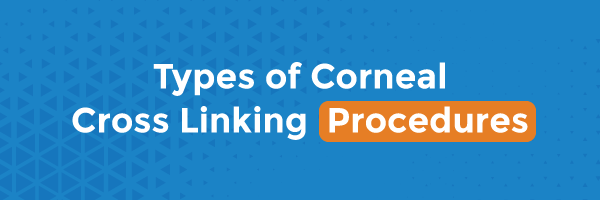DISCLAIMER! The information on this website is general information. Please discuss with your surgical provider your concerns and questions about the procedure. Your personal health information may differ from the information presented here.
Corneal Cross Linking Surgery
Corneal collagen cross-linking is a surgical procedure that strengthens the cornea in order to prevent progressive thinning and worsening of astigmatism that can be caused by keratoconus, pellucid marginal degeneration, or other forms of corneal ectasia (or “warpage.”). This is the first procedure that has been shown in numerous studies to slow or stop the worsening of these disorders. The approval of “epithelium-off” Dresden protocol cross-linking using the Avedro UV light and riboflavin marked an important advance in the care of corneal ectasia in the United States. Cross-linking is helpful for patients who have progressive corneal ectasia changes on corneal topography testing or based on a history of worsening vision associated with an increase in nearsightedness and/or astigmatism. Corneal ectasia tends to progressive more rapidly in younger patients, so children, adolescents, and patients in their 20’s are generally treated more aggressively. Younger patients should be screened for progression more frequently or treated more quickly in order to prevent progression and loss of vision. The procedure is performed on one eye at a time, usually starting with the eye that has more severe corneal changes or more rapid progression. Cross-linking is generally not done if a patient has severe corneal scarring or if the cornea is too thin at which point a corneal transplant (PK or DALK) may be most appropriate.
Cross-linking is done in the office for the majority of patients. The procedure involves removal of the corneal epithelium, soaking the cornea for approximately 30 minutes with riboflavin drops, and activation of the riboflavin with a 30-minute exposure to the Avedro UV source. After the exposure is complete and the cornea has been cross-linked, a bandage contact lens is placed on the eye. There is usually some discomfort for the first several days after the procedure as the corneal surface heals. The bandage contact lens is removed once the surface has fully healed. It generally takes 3 months for the cornea to stabilize although some changes may be noted for up to 1 year after the procedure. Once the cornea is stable, the patient may be tested for a new pair of spectacles or fitted for a new contact lens.
Our team of ophthalmologists are highly-experienced and specialized in corneal collagen cross-linking surgical procedures. If you have any questions or suspect you may need this type of surgery, reach out to us today to learn more.

Symptoms
Corneal cross-linking surgery is used to treat astigmatism, which is an imperfection in the curvature of your eye. In these cases, astigmatism is progressive and is often caused by keratoconus, pellucid marginal degeneration, or other forms of corneal ectasia (or “warpage.”). Over time, these conditions cause the front part of your eye (cornea) to thin out and get weaker, which impacts your vision.
Generally, the symptoms of astigmatism include blurred or distorted vision, eyestrain or discomfort, squinting, headaches, difficulty reading or with night vision, and related symptoms. If you notice any of these symptoms, it is recommended that you see an eye doctor immediately before they can progress further.

Understanding the Procedure
The cross-linking procedure itself usually takes about an hour or so to complete (per eye) and is an outpatient procedure. The procedure is performed on one eye at a time, usually starting with the eye that has more severe corneal changes or more rapid progression. Fortunately, the procedure is painless, and anesthetic eye drops will be used to avoid any discomfort for the patient. After the epithelium-off or epithelium-on cross-linking surgery is performed, a bandage contact lens will be placed on your eye to reduce discomfort and facilitate healing.

Types of Cross Linking Procedures
Corneal cross-linking procedures involve two steps. First, specialty formulated riboflavin (vitamin B) eye drops are applied to the surface of the eye. Next, a controlled exposure of ultraviolet light is performed. There are two primary types of corneal cross-linking procedures:
- Epithelium-off cross-linking: During this type of cross-linking procedure, the epithelium, or thin outer layer of the cornea, is removed. This allows the liquid riboflavin to penetrate the deeper corneal tissue more easily.
- Epithelium-on cross-linking (AKA transepithelial cross-linking): This less-invasive procedure leaves the protective corneal epithelium intact. Your doctor loosens the epithelium with eye drops or a sponge before they insert the eye drops.
An eye doctor can walk you through these options in more detail and help you determine which is best for you.

Preparing for Surgery
Before cross-linking surgery, an eye doctor will make a preliminary evaluation to assess your vision and eye health, measure the thickness of your cornea, and determine whether you’re a good candidate for the procedure. If so, they will then carry out detailed mapping of your cornea to prepare for the surgery.
Your eye doctor will provide detailed instructions, which you should follow carefully, to help you prepare for the procedure. Typically, you will be advised not to apply any eye makeup, perfume, or aftershave on the day of the surgery. It’s normally permissible to eat and drink fluids before the surgery, but check with your doctor to be sure. Lastly, it’s a good idea to arrange for someone to drive you home after the surgery.

Corneal Cross Linking Recovery Process
After the corneal cross-linking procedure has been completed, topical antibiotic and anti-inflammatory drops may be prescribed by your eye doctor. Your doctor will also insert a contact lens to aid in the healing process. It is normal to experience some eye discomfort or sensitivity to light for the next few days, but if you have any severe pain or notice worsening of your vision, you should contact your doctor immediately. It is also normal to experience blurred vision during the recovery process. The bandage contact lens is removed once the surface has fully healed. It generally takes 3 months for the cornea to stabilize although some changes may be noted for up to 1 year after the procedure. Once the cornea is stable, the patient may be tested for a new pair of spectacles or fitted for a new contact lens.

Cost of Surgery
The average cost of a corneal cross-linking procedure typically ranges from $2,500 to $4,000 per eye. Insurance coverage is widely available, depending on the type of procedure. For a more accurate idea of the total out-of-pocket cost, talk to your eye doctor and your insurance company about your options.

Cross Linking Eye Surgery FAQs
What is Corneal Cross Linking?
Corneal cross-linking is a surgical procedure that strengthens the cornea in order to prevent progressive thinning and worsening of astigmatism, which can be caused by keratoconus, pellucid marginal degeneration, or other forms of corneal ectasia (or “warpage.”).
How Long Does Cross Linking Last?
A corneal cross-linking procedure typically takes around one hour or so to complete, per eye.
Is the procedure an Effective Keratoconus Treatment?
The primary purpose of corneal cross-linking for keratoconus is to prevent the condition from worsening. It is highly effective for this preventative purpose; in fact, the success rate is more than 95% for ‘epi-off’ treatments. Additionally, studies show that many patients also report improved vision after corneal cross-linking, though this is not guaranteed.
What is Collagen Cross Linking?
Collagen cross-linking is another commonly used term that refers to the same procedure as corneal cross-linking.
Does Insurance Cover the procedure | surgery?
Insurance coverage for corneal cross-linking is widely available, depending on the type of procedure and your insurance provider. Be sure to check with your eye doctor and insurance provider for more specific information.
Is the procedure painful?
In the vast majority of cases, corneal cross-linking is a painless outpatient procedure. Your eye doctor will apply anesthetic eye drops in order to minimize any discomfort.
What is the Success Rate of the procedure?
The success rate for corneal cross-linking is around 95%, depending on the specific type of procedure and other factors.
Corneal Cross Linking Specialists

Click Here to Request an Appointment with our specialists about corneal cross linking surgery!